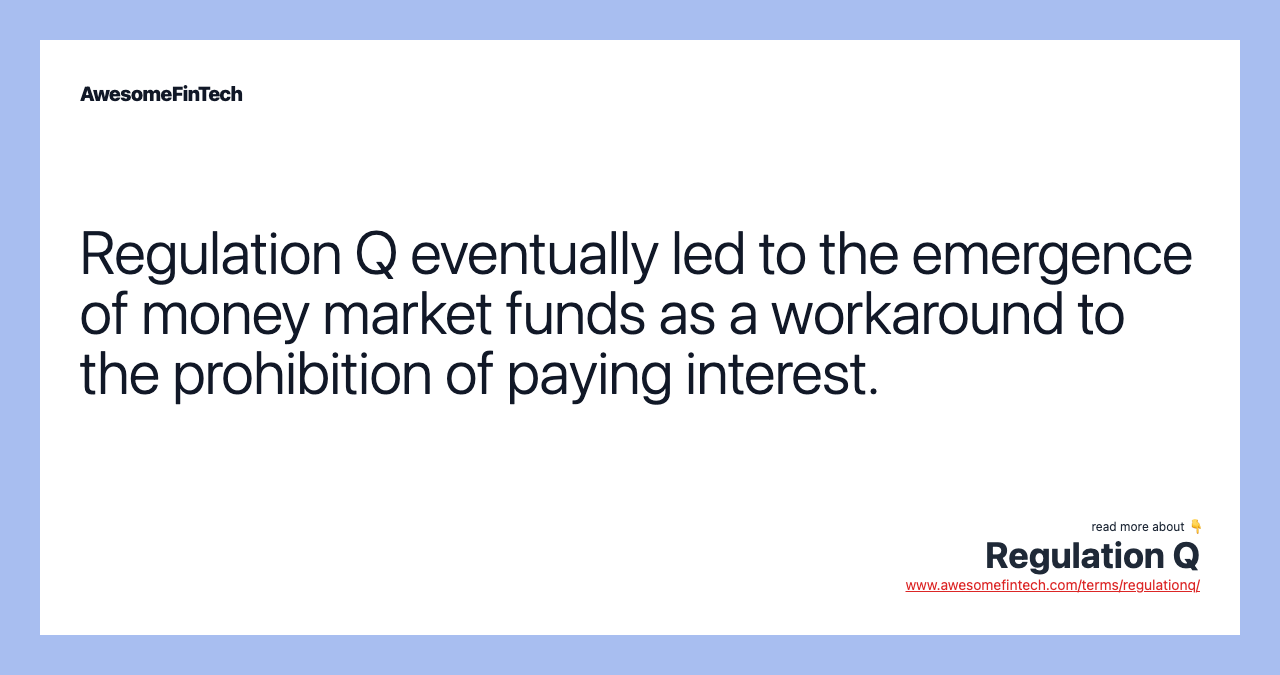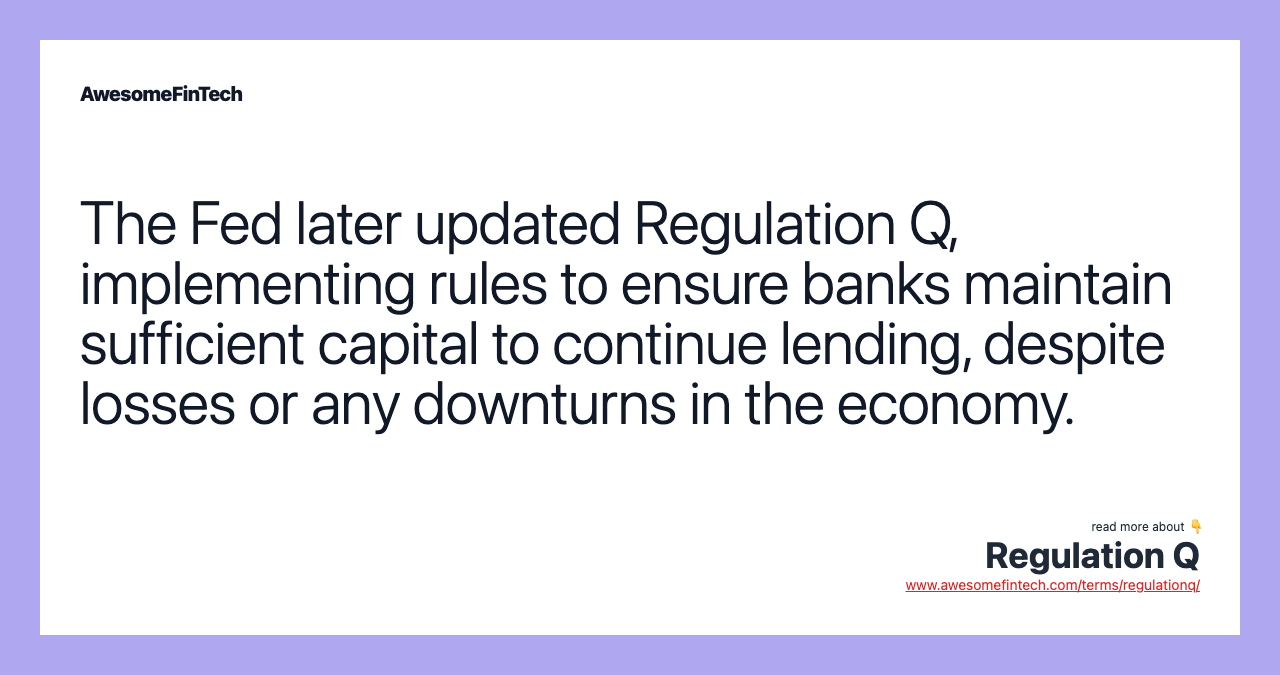Regulation Q
Regulation Q is a Federal Reserve Board (FRB) rule that sets "minimum capital requirements and capital adequacy standards for board regulated institutions" in the United States. These rules included a minimum ratio of common equity Tier 1 capital to risk-weighted assets of 4.5%, and a common equity Tier 1 capital conservation buffer to risk-weighted assets of 2.5%, as well as a supplementary leverage ratio of 3% for large banks that are internationally active, which takes into consideration off-balance sheet exposure. In 2013, the Federal Reserve (Fed) issued an updated Regulation Q, designed to ensure banks maintain sufficient capital to be able to continue lending, regardless of losses or any downturns in the economy. In 2011, Regulation Q was repealed by the Dodd-Frank Wall Street Reform and Consumer Protection Act, allowing banks that are members of the Federal Reserve System (FRS) to pay interest on demand deposits. The purpose of these measures was to limit speculative behavior by banks competing for customer deposits as it led to banks seeking risky means of profit to be able to pay the interest on these deposits.

More in Economy
What Is Regulation Q?
Regulation Q is a Federal Reserve Board (FRB) rule that sets "minimum capital requirements and capital adequacy standards for board regulated institutions" in the United States. Regulation Q was updated in 2013 in the aftermath of the 2007–2008 financial crisis and continues to go through changes.



Understanding Regulation Q
The original rule was created in 1933, in accordance with the Glass-Steagall Act, with the goal of prohibiting banks from paying interest on deposits in checking accounts. It also enacted ceilings on the interest rates that could be paid in other types of accounts.
The purpose of these measures was to limit speculative behavior by banks competing for customer deposits as it led to banks seeking risky means of profit to be able to pay the interest on these deposits. This was later commonly regarded as a means of financial repression.
Regulation Q eventually led to the emergence of money market funds as a workaround to the prohibition of paying interest.
Repealing Regulation Q
In 2011, Regulation Q was repealed by the Dodd-Frank Wall Street Reform and Consumer Protection Act, allowing banks that are members of the Federal Reserve System (FRS) to pay interest on demand deposits. This action was taken to increase a bank's capital reserves and, subsequently, mitigate any credit illiquidity — one of the causes of the 2007–2008 credit crisis.
Response to the repeal was mixed. Detractors claimed it would result in increased competition for customer deposits and that larger banks would be in a better position to offer higher interest rates, thereby hurting smaller community banks. They also cited increased costs of funding and higher expenses.
Supporters, on the other hand, argued that the repeal would result in more innovative products, greater transparency, and a stable source of capital.
Current Regulation Q Requirements
In 2013, the Federal Reserve (Fed) issued an updated Regulation Q, designed to ensure banks maintain sufficient capital to be able to continue lending, regardless of losses or any downturns in the economy.
Certain institutions are exempt from having to meet the capital requirements, including bank holding companies with less than $100 billion in total consolidated assets.
These rules included a minimum ratio of common equity Tier 1 capital to risk-weighted assets of 4.5%, and a common equity Tier 1 capital conservation buffer to risk-weighted assets of 2.5%, as well as a supplementary leverage ratio of 3% for large banks that are internationally active, which takes into consideration off-balance sheet exposure.
In 2020, the Fed then adopted a final rule to determine a company's capital buffer requirement, opting to use the results of a supervisory stress test, rather than the static 2.5% of risk-weighted assets component.
Related terms:
Antitrust
Antitrust laws apply to virtually all industries and to every level of business, including manufacturing, transportation, distribution, and marketing. read more
Capital Buffer
A capital buffer refers to extra capital required by regulators for financial institutions to ensure a more resilient global banking system. read more
Capital Requirements
Capital requirements are standardized regulations for banks and other depository institutions that determine how much liquid capital (that is, easily sold assets) they must hold for a certain level of assets. read more
Common Equity Tier 1 (CET1)
Common Equity Tier 1 (CET1) is a component of Tier 1 capital that is mostly of common stock held by a bank or other financial institution. read more
Demand Deposit
A DDA or demand deposit account consists of funds held in an account that can be withdrawn by the account owner at any time from the depository institution. read more
Dodd-Frank Wall Street Reform and Consumer Protection Act
Dodd-Frank Wall Street Reform and Consumer Protection Act is a series of federal regulations passed to prevent future financial crises. read more
Economy
An economy is the large set of interrelated economic production and consumption activities that determines how scarce resources are allocated. read more
Federal Reserve Board (FRB)
The Federal Reserve Board (FRB) is the governing body of the Federal Reserve System, the U.S. central bank in charge of making monetary policy read more
Glass-Steagall Act
The 1933 Glass-Steagall Act prohibited commercial banks from conducting investment banking activities, and vice versa, for over 60 years. read more